Clancy Tucker's Blog, page 124
March 1, 2019
2 March 2019 - A BUNCH OF TOP QUOTES

A BUNCH OF TOP QUOTES
G'day folks,
Welcome to another set of top quotes, and don't forget to send them to anyone who might need them.











Clancy's comment: Mm ... Any grab you by the throat?
I'm ...


Published on March 01, 2019 12:57
February 28, 2019
1 March 2019 - Dragonflies Embark on an Epic Migration Each Year

Dragonflies Embark on an Epic Migration Each Year
G'day folks,
As a photographer, I'm always checking out wildlife, and these cute little things are another example of how amazing nature is. Monarch butterflies aren’t the only migratory marathoners in North America.
The green darner dragonfly, Anax junius, embarks on a rigorous, multi-generational migratory relay race up and down North America every year that largely goes unnoticed, according to a new study published in the journal Biology Letters .
Dragonfly experts knew that the common emerald green and blue insects migrated, but tracking the jet-setting three-inch-long insect is tricky. The slender insects are too small for radio trackers and don’t travel in easy-to-spot swarms like monarchs or birds. To bring the details of the dragonfly’s journey to light, researchers consulted 21 years of data collected by citizen scientists and analyzed more than 800 green darner wing samples collected over the last 140 years from museums, reports Susan Milius at Science News .

The team tested each wing sample for a chemical code that would indicate approximately where the bugs were born. From there, the researchers could figure out how far the dragonflies travelled as adults. To do so, they tested for three hydrogen isotopes—or chemical signatures—each of which vary geographically. Hydrogen accumulates in dragonfly larvae’s chitin, which is the stuff that eventually makes up their wings as adults. Identifying the isotope in each wing sample allowed researchers to narrow in on the dragonflies’ origin. The isotopes aren’t perfect, but they’re good enough to tell whether they originate in “Florida, Maryland or Maine,” reports Ben Guarino at The Washington Post .
The citizen science data allowed the team to figure out what types of natural cues, like temperature, give the dragonfly larvae the signal to emerge and migrate. Between February and March, the first generation of dragonflies emerges from ponds and lakes in the southern United States, Mexico and the Caribbean. Then those resilient first-gen bugs travel hundreds of miles north as, making it to New England or the upper Midwest by May. When they get there, they’ll lay their eggs and die.
The lives of the next generation are just as incredible. While some of those second generation insects will hang out and over winter in ponds and lakes in the north during their nymph stage, many will reach maturity and head south between July and October.
When those insects reach the south, they deposit another batch of eggs, which mature into a third generation that will live a non-migratory life over the winter on the coast, producing the eggs of the dragonflies that will migrate northward again in the spring.

“We know that a lot of insects migrate, but we have full life history and full migration data for only a couple. This is the first dragonfly in the Western Hemisphere for which we know this,” senior author of the paper Colin Studds of the University of Maryland, Baltimore County, says in a press release. “We’ve solved the first piece of a big mystery.”
The bigger part of the mystery—and one that applies to migrating butterflies and even birds—is how the insects know what path to take north and south and when they know to migrate. The data suggest that the insects begin migrating north once temperatures reach 48 degrees, Studds tells Guarino at The Washington Post. This may also happen because the days start to grow longer during this time as well.

Clancy's comment: Yep, nature keeps reminding us that we humans are not the smartest things on earth.
I'm ...


Published on February 28, 2019 12:44
February 27, 2019
28 February 2019 - THE GRAVE OF C.S. LEWIS

THE GRAVE OF C.S. LEWIS
G'day folks, The bones of C.S. Lewis, one of the 20th century’s literary greats, rest within a peaceful cemetery. Nearby, an etched glass window bearing characters from his most famous fantasy world adds a whimsical touch of childhood magic to the churchyard.
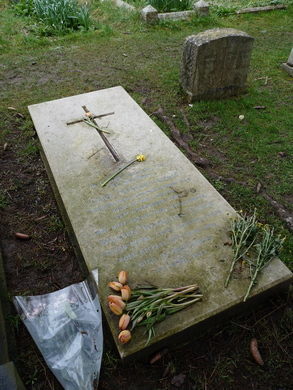
The grave of C.S. Lewis lies within the cemetery of the Holy Trinity Church in Headington Quarry just outside of Oxford. He was buried there in November of 1963, and even today it’s common to find flowers placed atop his tombstone.
C.S. Lewis is best known for his beloved fiction novels, notably The Chronicles of Narnia, The Screwtape Letters, and The Space Trilogy. He is also known for his popular works of non-fiction Christian apologetics, including Mere Christianity and The Problem of Pain.

Lewis was educated at Oxford University, which is only a couple miles from the churchyard. After serving in World War I, he returned to Oxford to become a tutor and fellow in English Literature at Magdalen College. He was one of the “Inklings” that brought weekly fractions of the fantasy realm to the town’s local haunts.

Influenced by close friendJ.R.R. Tolkien and others, Lewis returned to Anglicanism in 1930 and began attending Holy Trinity Church. The famous writer was a regular at the church’s 8:00 a.m. service, which he chose because of his dislike of organ music. In 1992, a gorgeous etched glass window featuring beloved Narnia characters was installed in the church. The fantasy scene is located adjacent to the pew where he always sat.



Clancy's comment: I doubt they will include a special etched glass window for me in our local church. If they do, I hope they include a bottle of wine and a pen.
I'm ...


Published on February 27, 2019 13:22
February 26, 2019
27 February 2019 - MICHELANGELO’S GROCERY LIST

MICHELANGELO’S GROCERY LIST
G'day folks,
Here's something different.
Michelangelo di Lodovico Buonarroti Simoni or more commonly known by his first name Michelangelo was an Italian sculptor, painter, architect and poet of the High Renaissance born in the Republic of Florence, who exerted an unparalleled influence on the development of Western art.
According to Michelangelo’s shopping list, genius thrives on a diet of fish, bread, and lots of wine.
Owned by the Casa Buonarroti museum in Florence, Italy, this 500-year-old list was written and illustrated by the sculptor/painter/poet/personality on the back of a letter. Michelangelo’s servant was likely illiterate, so Michelangelo sketched out what he wanted to eat.

And Michelangelo wanted a feast, spread out over three meals. He depicted bread rolls as quickly-drawn circles, and for one meal, Michelangelo wanted two rolls. For another, he wanted six. On the page, an elegant herring floats in the air, while bowls overflow with salad and anchovies. Two dishes of stewed fennel are sketched side by side, and when asking for a smaller amount of dry wine, Michelangelo carefully drew a small wine jug next to a larger one. Sadly, he did not draw two plates of tortelli—he only asked for the ravioli-like pasta pouches in writing.
The menu consists mostly of vegetables, fish, wine, and bread. This might seem particularly healthy, but the letter on the other side of the list is dated March 18, 1518, around the time of Lent. Since eating meat was frowned upon, Michelangelo ate the requisite vegetables. However, Gillian Riley writes in The Oxford Guide to Italian Foodthat this was definitely an upscale menu. Despite his frugal reputation, the artist was probably used to dining with nobility.

By 1518, Michelangelo had already finished many of his most famous works, including the Pietà, the David, and the Sistine Chapel ceiling. But among all his work, this rough list is perhaps the most down-to-earth glimpse of the artist himself. It’s interesting to imagine the famously mercurial Michelangelo taking the time to illustrate for his servant what he wanted for dinner.

The survival of this list is remarkable, too. Only around 600 of Michelangelo’s sketches still exist. 1518 marked the year that Michelangelo burned many of his early drawings, and 46 years later, he ordered many of his papers to be torched in anticipation of his death. Maybe he wanted to preserve the aura of divine genius that surrounded his art. A list showing his sketched takeout order might not have given the right impression.

Clancy's comment: There ya go. Even the famous had shopping lists.
I'm ...


Published on February 26, 2019 13:04
February 25, 2019
26 February 2019 - THE BLUE WILDEBEEST
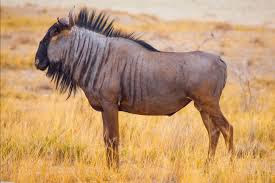
THE BLUE WILDEBEEST
G'day folks,
Welcome to some interesting facts about another amazing creature that seems to be able to survive in harsh surroundings.
These majestic animals cross vast distances in huge numbers when migrating to find food and water. Wildebeests, also called gnus, are antelopes in the genus Connochaetes. They belong to the family Bovidae, which includes antelopes, cattle, goats, sheep, and other even-toed horned ungulates.

Amazing Facts About the Blue Wildebeest
Blue Wildebeest got name as their coat has a blue sheen.There are around 1.5 million living in the Serengeti alone! They are widespread in many areas of Africa.Their main defence from predators is living in a group. Wildebeest stick together and move in herds to be more safe.They can run up to 40 mph, which is pretty fast! Although, unfortunately for them, not as fast as lions or cheetahs.
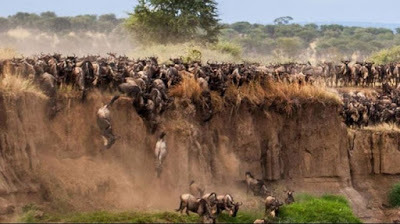
Blue Wildebeest Migration
They migrate as many as 1000 miles each year – that’s longer than the length of Britain and around the same distance from Minnesota to Louisiana. That distance would take around 20 hours to drive.They have a dangerous migratory route, during their migration they cross two rivers – both of which are crocodile infested. Quick FactsType: MammalSize: 58 inchesWeight: 600lbsLife span: 40 yearsHabitat: Savanah, grasslandsDiet: HerbivoreScientific Name: Connochaetes taurinus
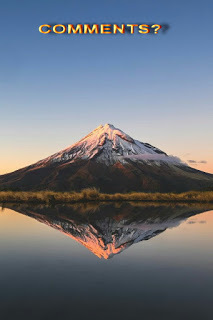
Clancy's comment: Amazing how many of them are left, eh?
I'm ...


Published on February 25, 2019 12:35
February 24, 2019
25 February 2019 - TOWN IN GUATEMALA SOLVES PLASTIC PROBLEM
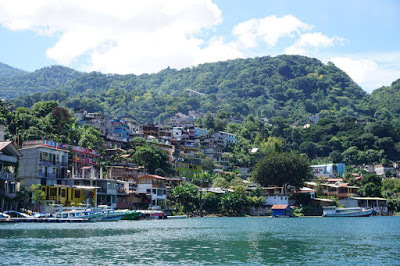
TOWN IN GUATEMALA SOLVES PLASTIC PROBLEM
G'day folks,
In San Pedro La Laguna, single-use items made from plastic and styrofoam are banned.
At dawn, the market is bustling with all the usual suspects. A vendor prepares tostadas with an array of colorful toppings from sautéed beetroot to homemade guacamole. In the next stall, a woman is pounding out blue corn tortillas by hand—the rhythm of her labor echoes throughout the market, setting a lively tempo. Nearby a farmer is selling fresh produce from wicker baskets.

Inhabitants of San Pedro La Laguna are primarily Tz’utujil Maya. Local ladies don colorful textiles, carrying the history of their ancestors in the threads. They carry equally bright woven rubber basket bags that they fill to the brim with goods. The baker and pharmacist are busy handcrafting paper packaging for their products. Men wearing traditional woven hats sit on the shallow steps of the town’s Catholic church as children play in the stark white courtyard.
Before 2016, San Pedro La Laguna was drowning in plastic pollution that was threatening the fragile ecosystem of Lake Atitlán. The dire need for change crystallized when a solid waste disposal processing plant that was expected to manage a decade of waste was halfway full within six months, mostly with single-use plastics. Rather than build a larger plant—which would’ve been an enormous financial burden on the town and further polluted the lake with debris—Mayor Mauricio Méndez decided to implement a stringent municipal law to encourage lasting, sustainable change.

Méndez took unprecedented measures and established a zero-tolerance policy, banning single-use items made of plastic or styrofoam including bags, straws, and containers. San Pedro La Laguna was the first town in Guatemala to enact such a drastic ordinance against waste.
Villagers initially resisted, as they’d become accustomed to using materials that were now outlawed. To get rid of the single-use plastics already in circulation, leaders of the 13,000-person town went from house to house to talk with villagers about waste management. Residents were wary because they couldn’t afford to purchase biodegradable replacements. The government relieved the community members’ financial burden by collecting all plastic and styrofoam items and trading them for reusable or biodegradable alternatives, completely free-of-charge.
Victor Tuch Gonzáles, the municipal planning director, says eliminating the use of plastic bags was the biggest hurdle. To alleviate this issue, the municipality purchased 2,000 handmade rubber basket bags from artisans in Totonicapán to distribute among families. Gonzáles says the switch to reusable items, including the bags, cost the municipality 90,000 GTQ ($11,632).

Economic sanctions punish anyone who breaks the law. Individuals must pay 300 GTQ ($40)—a hefty amount considering Guatemala’s average lower-middle-class annual income is $1,619. Companies that use the banned materials face a fine of 15,000 GTQ ($1,940).
The town also needed a better system to process waste. According to Gonzáles, Cementos Progreso and the Pro Verde NGO process the town’s trash into fuel or other derivatives. Local fisherman joined the sustainable efforts and created their own initiative to remove garbage from Lake Atitlán. Several projects have launched to transform trash into decorations which encourages the mentality of reducing, recycling, reusing, and regenerating.
Gonzáles says that the ideology has “returned to what was used ancestrally.” The community has returned using hoja del maxán (large leaves) to package meat from the butcher and cloth napkins to carry tortillas. Vendors wrap items in paper as if plastic had never tormented the town. Once the reusable rubber bags have been filled to the brim, ladies stash dry goods in their aprons.
Some businesses are starting to use paper straws. Gonzáles prefers to avoid any single-use items, as he sees no reason not to drink straight from the can, bottle, or glass. Gonzáles jokes that “You don’t need a straw for beer, so why use one for soda?”
By restoring and preserving the natural beauty of the lake, San Pedro La Laguna has attracted more tourists. Tourism is the largest economy in San Pedro La Laguna—visits to the town increased by 40 percent in 2018. Travelers are also prohibited from using plastic bags, straws, and styrofoam containers in the town.

Méndez and Gonzáles hope their efforts will be replicated by other townships on Lake Atitlán in order to align preservation efforts and honor Mother Earth—a significant figure of Mayan spirituality. The ecological municipality is developing additional environmental conservation projects including residual wastewater treatment plants, switching to LED lights, prohibiting sand extraction from the lake, and using waste as building materials to build tables and chairs for local schools. Gonzáles believes that these efforts will “have a positive impact not only on the environment but also the economy of local people.”
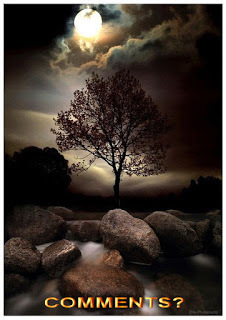
Clancy's comment: Brilliant. Looks like a great place to visit.
I'm ...


Published on February 24, 2019 13:02
February 23, 2019
24 February 2019 - THOMAS RUSSELL - GUEST AUTHOR
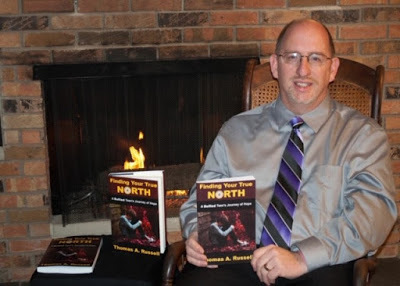
THOMAS RUSSELL - GUEST AUTHOR -
G'day folks,
Today, I interview an author from the USA who has written a book on bullying.
Welcome, Thomas ...
1. TELL US A LITTLE ABOUT YOURSELF AND YOUR WRITING JOURNEY.
I grew up in a small town in the United States. I was heavily involved in sports, but my journey into writing began in third grade when the class competed in a spelling contest for a week. Each day we played, and each day I didn’t misspell a single word. I was hooked.
2. WHEN AND HOW DID YOU BECOME A WRITER?
When I was in the fourth grade, my teacher was the first to encourage me to write. Of course, at that age, you don’t believe it. But I continued to write through school, until I found a job as a managing editor of a national magazine when I was 25. I had arrived...or so I thought. After six years, the magazine suffered through a recession, and I had to leave. My dream died soon after. 27 years later, after toiling in unfulfilling management jobs, I decided to write my first book.
3. WHAT TYPE OF PREPARATION DO YOU DO FOR A MANUSCRIPT? DO YOU PLAN EVERYTHING FIRST OR JUST SHOOT FROM THE HIP?
Whenever I decide to write anything, I make sure I write for an audience of one—me. If it passes my criteria, I pursue it. The biggest thing is to think of each story as a three part play. The first act is introduction of the protagonist. The second act is putting the character into situations where he/she faces some dilemma that must be solved. The third act is how the challenges are resolved. I know how the story ends even before I start. I just put the pieces of the puzzle together, allowing myself to be flexible as the story evolves.
4. WHAT DO YOU ENJOY MOST ABOUT BEING A WRITER?
I get satisfaction of writing something where people can read and be impacted by something I have written. I wrote my first book on bullying, and realized how it affected those who have suffered from being oppressed. You get a writer’s high sometimes where the words just flow. When you get to that point, you just think, “Wow, did I just write that?”
5. WHAT IS THE HARDEST THING ABOUT BEING A WRITER?
When you know where you want to go, and you just stare at the page and think, “Where are you going with this?” The biggest thing, however, is when you write a book, you want for the masses to catch hold of it. It’s not because of making money. It’s more that what you write is important. I don’t write for platitudes. I simply want to change people’s lives by what I write. It’s hard to get that message across sometimes.
6. WHAT WERE YOU IN A PAST LIFE, BEFORE YOU BECAME A WRITER?
I was in restaurant and convenience store management for more years than I care to admit. It’s just when you get stuck in the rut, you feel like that’s the only thing you will ever accomplish in life.

7. WHAT IS YOUR GREATEST WRITING ACHIEVEMENT?
Most definitely it’s when I published my first book, “Finding Your True North: A Bullied Teen’s Journey of Hope.” That book was a culmination of dreams unfulfilled. I just got tired of the woulda-shoulda-coulda life I was leading. I just made a conscious decision not to quit.
8. WHAT ARE YOU WORKING ON AT THE MOMENT?
It is going to be a companion book to the first one on bullying. I am compiling stories from people who have been bullied in school, home, work, spousal abuse, narcissism, and even those who have bullied. It’s called “You Are Not Alone.” The stories I have received and the live interviews I have conducted have brought many tears. But at the same time, there’s a sense of catharsis for those who have the courage to share their traumatic stories. I am truly humbled by them to allow me to present their lives.
9. WHAT INSPIRES YOU?
Being able to make a difference in people’s lives. Too often we get caught up in every day life and put blinders on. Can you imagine how our culture would be world-wide if each person stepped out of their comfort zone just to simply tell someone else that they matter? It doesn’t require money. I love to know that I can follow Jesus Christ’s edict to love they neighbor with conviction.
10. WHAT GENRE DO YOU WRITE?
My first two books were fiction, rooted in real life situations. The third book that I’m waiting to get published is a biography about a drummer from a Motown group. Of course, this next one is an anthology. The next one after that is a humorous true account of my life as a transport driver.
11. DO YOU HAVE ANY TIPS FOR NEW WRITERS?
If you want to pursue writing a book, a story, a poem, anything that is creative, you have to find your “Why.” Why do you want to write? Is it for fortune (good luck with that)? Is it for fame (rare)? Is it you just want to say you’ve written something? Once you answer those questions, just do it. Write for yourself, but at the same time, if you really want to get published, know your audience. If you write something that nobody wants to read, you’re just treading water. But if you write something that has some intrinsic value that stirs the mind of the reader, you will always win.
12. DO YOU SUFFER FROM WRITER’S BLOCK?
When I get in the groove of writing, the words flow freely. With my second book, “Nowhere Man,” I wrote 40,000 words in a month. I was jamming. This anthology is a little challenging, merely because I’m relying on others to provide their stories. Still, I’m struggling with the context of this book. I don’t want people to read these stories and feel hopeless.

13. DO YOU HAVE A PREFERRED WRITING SCHEDULE?
I like to write early in the morning or late at night. I seem to be the most creative then.
14. DO YOU HAVE A FAVOURITE WRITING PLACE?
I can write anywhere. I have to ability to tune out the noise.
16. WHO IS YOUR FAVOURITE AUTHOR AND WHY?
It is most definitely Jaimie Engle, a nationally renowned author in Florida. When I read her first book, “Clifton Chase and the Arrow of Light,” I was hooked. She immerses her characters into situations that elicit emotional attachment. But her latest book, “Metal Mouth,” is probably the best book I’ve ever read. It took me a day to read, because I couldn’t put it down. I even took it into a restaurant and ended up crying like a baby when I got to end. Let me tell, when an author can write something so powerful that it makes you cry, it’s an amazing experience.
17. WHAT’S THE GREATEST COMPLIMENT YOU EVER RECEIVED FROM A READER?
Because my first book was on bullying, I heard many favorable compliments. But when I heard from someone who had considered ending his life until he read my book, I was floored. But at the same time, I felt a sense of responsibility to carry on my crusade to let people know they matter, that they have value.
18. WHAT WAS THE WORST COMMENT FROM A READER?
I don’t consider it a bad comment, but one reader didn’t like how my second book ended. She wanted everything wrapped into a tight bow, but I convinced her that life doesn’t always end positively.
19. WRITERS ARE SOMETIMES INFLUENCED BY THINGS THAT HAPPEN IN THEIR OWN LIVES. ARE YOU?
The genesis of my first book came because I volunteer as a mentoring coach for an organization. We teach these kids these five core values: sacrifice, integrity, respect, responsibility and courage. I wanted to write a book that focused on those values. Working with these kids for the past 12 years has changed my life. This organization has taught me to pursue my dreams and not give up.
20. OTHER THAN WRITING, WHAT ELSE DO YOU LOVE?
I love my wife dearly. She’s always been my biggest supporter. I’m also an avid sports enthusiast. I was a very accomplished athlete, so my love for sports is off the charts.
21. DID YOU HAVE YOUR BOOK / BOOKS PROFESSIONALLY EDITED BEFORE PUBLICATION?
I made the mistake not to find an editor for the first book. Although I worked with the publisher directly during the editing process, I found mistakes that I missed. It is maddening. With my second book, I made sure I had someone edit my book. She did a fantastic job. With the biography, I worked with an editor on the app FIVERR. He did an incredible job. If there’s any advice, never, ever skimp on finding an editor. That will make or break your book.

22. DESCRIBE YOUR PERFECT DAY.
Waking up next to my wife, and not have to worry about doing anything for a whole day.
23. IF YOU WERE STUCK ON A DESERT ISLAND WITH ONE PERSON, WHO WOULD IT BE? WHY?
It would have to be Jesus Christ. I would never consider it being stuck, that’s for sure. I would love to hear His sage words and to show me how to live my life.
24. WHAT WOULD YOU SAY IF YOU HAD THE CHANCE TO SPEAK TO WORLD LEADERS?
I would say, “What’s the point of you doing everything you can do to make everyone feel you are superior over others?” It serves no purpose. “Why don’t you just accept the fact that we all have differences?” It’s not the matter of who is right and who is wrong.
25. WHAT ARE YOUR PLANS FOR THE FUTURE?
Continue writing until I die.
26. WHAT ARE YOUR VIEWS ON BOOK TRAILERS? DO THEY SELL BOOKS?
I’m not sure how to answer that, mainly because I’ve never been involved with book trailers.
27. DO YOU SEE YOURSELF IN ANY OF YOUR CHARACTERS?
Oh, yes. The 14-year-old teenager in the bully book had elements of my life in there. I went through my share of bullying at that age.
28. DOES THE PUBLISHING INDUSTRY FRUSTRATE YOU?
I don’t focus on the negativity of publishing. You create your own destiny. Being a self published has it’s drawbacks, of course, but the idea you can create something from the very beginning and to see it to the end is the most gratifying thing.
29. DID YOU EVER THINK OF QUITTING?
When I was younger and felt I wasn’t good enough, for sure. But when I turned 52, I said enough is enough. There is no turning back. Ever!
30. WHAT WAS YOUR FAVOURITE MANUSCRIPT TO WRITE? WHY?
It would have to be the first one, “Finding Your True North.” When I finally made the decision to write the book and saying that I would not give up, that had to be the most empowering thing I have ever done. I just realized that the only thing that stopped me before was me and not the fake circumstances that bogged me down.
31. HOW WOULD YOU DEFINE ‘SUCCESS’ AS A WRITER.
Success is not making money. Yeah, it would be great, but when yourself finally see your name on the front of the book, you can honestly say you have done something that the majority of people will never do. You published a book. If doesn’t matter if people don’t read it. It would be nice, but you just won the literary lottery.
32. WHAT SHOULD READERS WALK AWAY FROM YOUR BOOKS KNOWING? HOW SHOULD THEY FEEL?
That there is hope. You can go through life playing the victim, but eventually you have to understand that you have to empower yourself. I want people who read my books and finish saying, “That’s one of the best books I have ever read.”
I would love to see my first two books, “Finding Your True North” and “Nowhere Man,” made into movies. Bullying and homelessness are subjects that needs to be addressed. I have never written a screenplay, but I would love to write one.
34. HOW MUCH THOUGHT GOES INTO DESIGNING A BOOK COVER?
You always hear the phrase, “You can’t judge a book by it’s cover,” but in the publishing business, a book cover will make or break you. You have to research other books in a similar genre and come up with something that will catch the reader’s eyes.
35. WHAT’S YOUR ULTIMATE DREAM?
To get my first book in the hands of Dolly Parton.
36. WRITING IS ONE THING. WHAT ABOUT MARKETING YOU, YOUR BOOKS AND YOUR BRAND? ANY THOUGHTS?
The hardest thing when you self published is the onus is on you. You have to be very creative, tenacious and willing to hear the word, “no” many times. But you have to be relentless. The worst that could happen is for someone to say “I’m not interested.” So what. Move on. If you are passionate about what you wrote, soldier on and never give up.
37. ARE YOUR BOOKS SELF-PUBLISHED?
All of my books were self published, although the first one was through a hybrid publisher, Worldwide Publishing Group out of Houston. The publisher, Eddie Smith, was incredibly helpful in getting my book out. I highly recommend him.
38. DESCRIBE YOURSELF IN FIVE WORDS.
I am not a quitter
39. WHAT PISSES YOU OFF MOST?
Impatient people.
40. WHAT IS THE TITLE OF THE LAST BOOK YOU READ? GOOD ONE?
“Metal Mouth,” by Jaimie Engle. Best book I have ever read.
41. WHAT WOULD BE THE VERY LAST SENTENCE YOU’D WRITE?
Make a difference in someone’s life. Every day.

AMAZON

Clancy's comment: Thanks for sharing your world, Thomas. I have also written a book about bullying, so good luck. Sadly, bullying has gone to a whole new level today. Keep writing.
I'm ...


Published on February 23, 2019 13:15
February 22, 2019
23 February 2019 - JAPAN’S TSUNAMI STONES

JAPAN’S TSUNAMI STONES
G'day folks,
Hundreds of tsunami stones stand along the coast of Japan, stark warnings and reminders of the devastating impact of the country’s all too frequent tidal waves. The oldest were erected more than 600 years ago; some have been washed away by ever more powerful waves.

Japan has borne the brunt of some of the worst tsunamis in history. In 1707, a tsunami caused by the Hōei earthquake killed more than 5,000 people. The Great Yaeyama Tsunami of 1771 killed 8,439 people on Ishigaki Island and 2,548 more on Miyako. In 1896, the Sanriku earthquake sent two tsunamis crashing into coastal settlements, destroying some 9,000 homes and killing at least 22,000. More recently, the Tōhoku earthquake and tsunami of 2011 left 15,894 dead, 6,156 injured, and 2,546 missing.
Despite this tragic history, it’s proved all too easy for later generations to forget the warnings of the past. That’s where the tsunami stones come in. Dotted along the coast and ranging in height from 2 feet to 10 feet tall, these flat stones are especially common on Japan’s northeastern shores, often marking the highest point of a tsunami’s reach.

Each stone bears an inscription, although some are now too worn to read. Some act as monuments, giving death tolls from past tsunamis or marking mass graves of the victims. Others offer more direct advice. A tsunami stone in Kesennuma, a city in the Miyagi Prefecture, reads: “Always be prepared for unexpected tsunamis. Choose life over your possessions and valuables.”
One particularly well-documented tsunami stone stands in the village of Aneyoshi on Japan’s northeastern coast. Aneyoshi had endured two devastating tsunamis, one in 1896 and another in 1933. The stone was placed shortly after the 1933 tsunami, a four-foot-high marker located just above the tsunami’s highest reach. It reads: “High dwellings are the peace and harmony of our descendants. Remember the calamity of the great tsunamis. Do not build any homes below this point.”
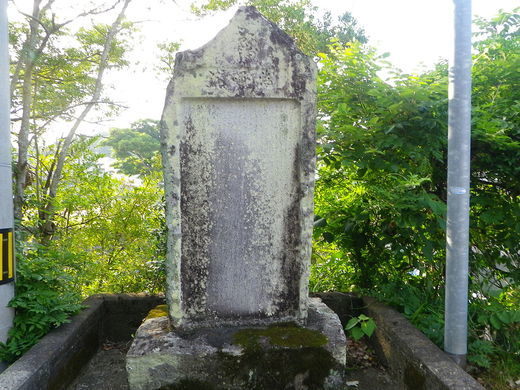
When the stone was placed, the remaining residents of Aneyoshi—there were only four—moved uphill for good. Heeding the advice of the tsunami stone, they moved above the reach of the last tsunami, which undoubtedly saved them from being devastated once again in the tsunamis of 1960 and 2011.

Clancy's comment: The devastation caused by a Tsunami is included in one of my books - Pa Joe's Place.
I'm ...


Published on February 22, 2019 13:26
February 21, 2019
22 February 2019 - STUNNING PICTURES THAT MOVE

STUNNING PICTURES THAT MOVE
G'day folks,
It's time for some pictures that rock and roll.












Clancy's comment: Mm ...
I'm ...


Published on February 21, 2019 12:26
February 20, 2019
21 February 2019 - DUTCH WINDMILL BUILT IN THE USA IN THE 1850’S
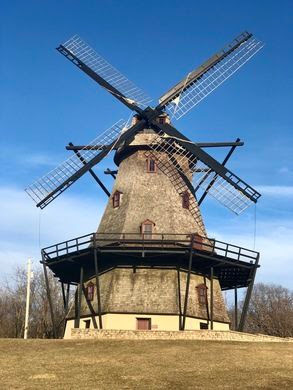
DUTCH WINDMILL BUILT IN THE USA IN THE 1850’S
G'day folks,
This prominent and authentic landmark does not belong to the Dutch, but sits along the bank of northern Illinois’ Fox River.
The 68-foot, 5-story mill was originally constructed in the 1850s by German craftsman Louis Blackhaus, about 20 miles from its current location in Geneva, IL for a total of $900. The mill was built from a kit which was shipped to the Midwest and assembled on site. Following several changes of ownership and continued use, the windmill had its sails damaged by a storm in 1912, prompting the owner to look for a buyer.
The windmill was then purchased by wealthy Geneva resident Colonel George Fabyan in 1914 for $8,000. His motive for purchasing the damaged mill remains unknown. Fabyan spent more than a year and a half and nearly $100,000 to have the windmill moved to its current location along the Fox River, a move completed through a painstaking process of deconstruction and reassembly. He also made modernizations while the mill was moved, including a new foundation, creating a basement level.
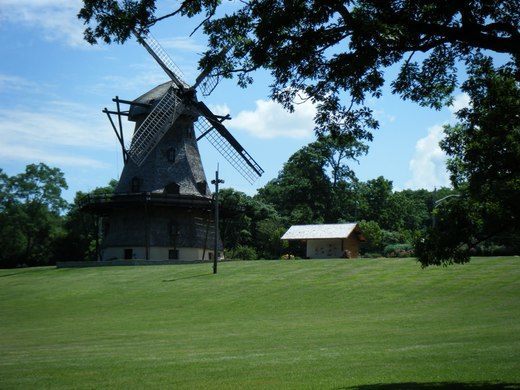
This additional level brought the mill’s total to six floors, the tallest in Illinois. He made more alterations over the years, adding windows to the fourth floor and interspersing iron into some of the wooden components. Upon the death of the Colonel in 1936 and that of his wife two years later, the entire estate was sold to the Kane County Forest Preserve.
The windmill immediately became a popular tourist attraction, cited as the most photographed structure in the region. The mill was open to the public and regularly had tours; remarkably the mill stayed in good condition for a long period of time. By 1990, the building was deemed structurally unsafe for public inspection. A group of activists fought to keep the mill intact, and the Forest Preserve District eventually hired Lucas Verbij, a world-renowned third-generation Dutch millwright, to restore and renovate the mill. After a lengthy and expensive process, the windmill had a grand reopening in June 2005.

The windmill now largely resembles its appearance during Fabyan’s ownership, with modern amenities such as fire alarms and flood lights. It is visible from a popular local running path and its slope is a very popular sledding locale during wintertime, referred to locally as ‘windmill hill.’

Clancy's comment: I bet the Dutch would be pleased.
I'm ...


Published on February 20, 2019 12:51



